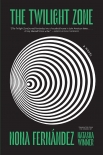The Twilight Zone Nona Fernández (e book reader for pc .TXT) 📖

- Author: Nona Fernández
Book online «The Twilight Zone Nona Fernández (e book reader for pc .TXT) 📖». Author Nona Fernández
But I’m one of them.
The boy with the ball is another.
From my present, which was once Don Alonso Gahona’s future, I imagine the truck in which he was abducted. I see it speeding past buses and cars along Gran Avenida itself, that September afternoon in 1975. It reaches Stop 20 and turns onto Calle Santa Teresa, pulling up here in front of the house, the same spot where I am now.
I imagine Don Alonso Gahona getting out of the truck.
Maybe Carol Flores is with him. Maybe he isn’t.
I imagine Don Alonso Gahona being pushed through this same gate I’m standing in front of. He doesn’t see me, of course. Actually, he doesn’t see anyone from beneath the blindfold covering his eyes. He just obeys and lets himself be led by his captors. He walks with difficulty. I imagine him stumbling over the two steps that I can see from here, at the front door, as the neighbors watch, too. Then I think I see a woman spying from the house across the street. She peers out, hiding behind the curtain. Or maybe she’s not hiding, and instead she stares openly as she waters the plants in her front yard. I imagine her and others like her watching the activity at this place day after day, as surprise turns into familiarity. The cries from torture sessions coexisting with the music on neighborhood radios, dialogue from the 3:00 p.m. soaps, the announcer’s voice on the broadcast of the soccer match. The prisoners going in and out of this gate became part of the landscape. Like the mailman, the municipal inspector, the children walking to school early in the morning. Hearing the occasional gunshot wasn’t strange anymore, it was part of the new sounds, the new habits, part of the daily routine that established itself emphatically, with no one daring to protest.
Little Major Gagarin, or Yuri Gahona, and his sister, Evelyn, never saw the scene that I’ve just imagined. They lived in the same district, but they didn’t know anything about Nido 20. Despite how near it was, no one told them what was happening here. They never came to look through the bars in hopes of spotting their father, never flew over the block in their imagination, scanning for him from up above in their white bishop spaceship. Like me, they never saw what was happening inside this house. To get inside and imagine what went on here, the only person who can help us is the man who tortured people: Andrés Antonio Valenzuela Morales, Soldier First Class, ID #39432, La Ligua.
The man who tortured people says that after he worked guarding political prisoners at the Air War Academy and a hangar at Cerrillos Air Base, he was transferred to Nido 20 to do the same thing. The man who tortured people says that his job there was to watch the detainees, take them to their torture sessions, bring them food, make sure they didn’t talk to each other. He says there were so many of them they had to expand into other detention centers. The man who tortured people says that at Nido 20 they had as many as forty prisoners at once. The man who tortured people says they had to use the closet for solitary confinement because there wasn’t room anywhere else.
Of course, he doesn’t say any of this to me.
I keep mixing up my tenses.
Present, future, and past mingle on this street in a time bracketed by the twilight zone stopwatch. Sitting in the front seat of the Renault van, that’s where I imagine him, outside the house with the lawyer. They watch the place surreptitiously from a distance, as they know how to do, without raising suspicions. They’ve gone on a long drive, visiting the places that the man described to the reporter. Cuesta Barriga, La Firma, the Cerrillos hangar, and now Nido 20. The lawyer wishes he had a camera, but instead he scrutinizes every detail, trying to memorize all he sees, just as I’m doing now. The man who tortured people is describing what he remembers about this house, and among his memories, he says that one of the prisoners who spent time there was Don Alonso Gahona. He says Don Alonso was known among his comrades by the nickname Yuri.
The first thing I see when I enter the house is a portrait of Don Alonso Gahona. It’s an oil painting, framed and hanging next to the fireplace. It’s a copy of the same photograph that I saw in the Museum of Memory. Alonso is smiling, wearing his thick glasses and bare-chested, because he’s at the beach, I think. The director of the center greets me and tells me that this is Comrade Yuri. He doesn’t say Alonso, he says: Yuri. Then he invites me in and asks me to sit down in what must once have been the living room. He asks me to wait a moment because he’s meeting with a comrade, introducing her





Comments (0)